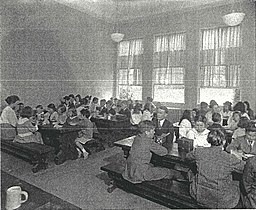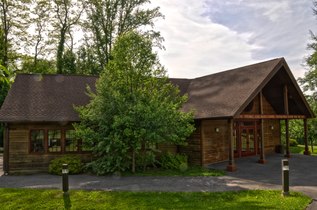Scarborough Day School
| Scarborough Day School | |
|---|---|
Coed | |
| Enrollment | 367 (peak in 1929) 150 (later years) |
| Campus type | Suburban |
| Yearbook | Beechwood Tree |
Scarborough Day School | |
| Area | 22 acres (8.9 ha)[2] |
| Architect | William W. Bosworth |
| NRHP reference No. | 84003433[1] |
| Added to NRHP | September 7, 1984 |
 | |
| Coordinates | 41°07′55″N 73°51′41″W / 41.131944°N 73.861306°W |
The Scarborough Day School[nb 1] was a private school in Scarborough-on-Hudson, in Briarcliff Manor, New York. Frank and Narcissa Cox Vanderlip established the school in 1913 at their estate, Beechwood. The school, a nonsectarian nonprofit college preparatory day school, taught students at pre-kindergarten to twelfth grade levels and had small class sizes, with total enrollment rarely exceeding 150 students.[3]: 46–7 Since 1980, the buildings and property have been owned by The Clear View School Day Treatment Center,[4]: 158 which runs a day treatment program for 118 students.[5] The current school still uses the Scarborough School's theater, which was opened in 1917. The school campus is a contributing property to the Scarborough Historic District.
The Scarborough Day School was accredited by the
History



The Scarborough School was founded in 1913 by
The school moved to its final location in 1917, at Vanderlip Hall, a building Vanderlip constructed in 1916 bordering Albany Post Road (current
Early on in the school's history, the Vanderlips decided to change the school's system from the Montessori method to a more formal approach with more discipline, although students still had more freedom than the average school. In the 1930s, the school was considered progressive: students were not graded and were instructed to work at their own speed. The school flourished during almost two decades under the helm of Dr F. Dean McClusky, who went on to a career as a professor in the Department of Education at
: 93The studio building was devoted to younger children (grades one, two, and three), and included a lunchroom, workshop, and art studio. Frank Vanderlip enjoyed teaching simplified political economy at the school; he would act out
Members of the Vanderlip family, particularly Virginia Vanderlip Schoales, continued to administer the school for sixty years. A 1959 development plan made way for a new primary school in 1961, new science facilities in 1962, expansion of the library in 1963, and the creation of an organization for alumni, of whom there were more than a thousand living in 1977.[3]: 47 The school was unable to obtain sufficient funding and closed in 1978. In 1980, the buildings and property were taken over by The Clear View School Day Treatment Center, which opened in September 1981 after major renovations.[4]: 158 The school runs a day treatment program for 118 students from nursery school age to 21,[5] and is sponsored by the Association for Mentally Ill Children of Westchester; its program involves education, treatment, and crisis intervention and parent involvement.[11]
Campus

The main Scarborough School building, Vanderlip Hall, was designed by William W. Bosworth, known for landscaping Kykuit and restoring Versailles. The school building was constructed in a severe, all-white Neoclassical style, and was completed early in 1917.[8] In addition to a grand porticoed entry, there were two wings that housed classes, a library, cafeteria and gymnasium, basement science labs, and an art room measuring 1,000 square feet (93 m2), ringed on three sides with French windows.[8] In the 1960s, an additional Modernist structure was built across a stream that would ultimately house the school's lower grades.
Theater

Beechwood Theater, a replica of the
The theater was used for assemblies, plays, concerts, and lectures. It was also home to the Beechwood Players, an adult performing arts group which had its origins in 1919.
The theater was opened and dedicated on January 2, 1917. The first concert took place on July 30, 1916, and was by Ignacy Jan Paderewski. During his performance, the Black Tom explosion took place at a munitions works in New Jersey, more than 30 miles (48 km) from Scarborough. Frank Vanderlip Jr., ten years old at the time, later recalled that he saw the detonation shake the jammed theater building, and that Paderewski had played on as if nothing had happened. The automatic fire doors at the top of the theater had sprung open, and two men were sent aloft to sit on them until the end of the performance to prevent a cold draft from entering the room.[4]: 96
Following the Scarborough School's closing, the Beechwood Theater had stood empty for many years, and was restored in 1983 by the Greater Ossining Area Community Theater. On March 17, 1984, The Clear View School presented a solo performance of Currier Bell, Esquire (a dramatization of
Alumni

Notable alumni of the Scarborough School include
The theatrical traditions of the school attracted many pupils with interests or family connections in the performing arts, including actresses
Headmasters
Headmasters included:[6]: 51
- Elizabeth Moseley Dean (1913–1916)
- Dr. Ernest Horn (1917–1918)
- Wilford M. Aikin (1918–1922)
- Morton Snyder (1922–1926)
- Dr. Arthur H. Sutherland (1926–1927)
- Dr. Frank M. McMurry (1927–1928)
- Dr. F. Dean McClusky (1928–1945)[24]
- Cornelius B. Boocock (1945–1948)
- Philip L. Garland (1948–1951)
- Thomas C. Schuller (1951–1961)[25][26]
- H. L. Richardson (1964–1965)[27]
- Robert C. Mellow (1967–1971)
- A.W. Rousseau (1971–1972)
- Donald F. Cantrell (1972–1974)
- Douglas G. Carner (1976–1978)
- Richard Pierce (1978)[28]
Gallery
-
School Auto repair shop in 1917
-
School studio building in 1917
-
School dining room in 1917
-
William T. Barnes Hall in 2014
-
The Thomas and Agnes Carvel Foundation Center for the Arts, opened May 17, 2006
See also
Notes
- ^ The school was also known as the Scarborough School or the Scarborough Country Day School.
References
- ^ "National Register Information System". National Register of Historic Places. National Park Service. March 13, 2009.
- ^ O'Brien, Austin (August 6, 1984). "National Register of Historic Places Inventory—Nomination form - Scarborough Historic District". National Park Service. United States Department of the Interior. Retrieved August 4, 2015. See also: "Accompanying photographs".
- ^ a b c d Midge Bosak, ed. (1977). A Village Between Two Rivers: Briarcliff Manor. Monarch Publishing, Inc.
- ^ OL 1884671M.
- ^ a b c d Klein, Alvin (June 17, 1984). "A Small Playhouse Is Returned To Use". The New York Times. Retrieved April 17, 2014.
- ^ OCLC 24569093.
- ^ Booth, Charles Edwin (1914). The Vanderlip, Van Derlip, Vander Lippe Family in America. Retrieved December 31, 2018.
- ^ ISBN 0-915585-14-6.
- ^ 1634–1699: McCusker, J. J. (1997). How Much Is That in Real Money? A Historical Price Index for Use as a Deflator of Money Values in the Economy of the United States: Addenda et Corrigenda (PDF). American Antiquarian Society. 1700–1799: McCusker, J. J. (1992). How Much Is That in Real Money? A Historical Price Index for Use as a Deflator of Money Values in the Economy of the United States (PDF). American Antiquarian Society. 1800–present: Federal Reserve Bank of Minneapolis. "Consumer Price Index (estimate) 1800–". Retrieved February 29, 2024.
- ^ "University of California: In Memoriam, 1985". oac.cdlib.org. Retrieved May 21, 2020.
- ^ "Westchester Guide: French Program". The New York Times. November 5, 1989. Retrieved June 18, 2014.
- ^ a b Herhenson, Roberta (March 15, 1998). "Honoring a Theater With 'My Fair Lady'". The New York Times. Retrieved June 19, 2014.
- ^ "Stephen Ailes ('36 JD)". West Virginia University Alumni Association. Archived from the original on September 17, 2011. Retrieved November 17, 2014.
- ISBN 1-59486-228-1.
- OCLC 951807303.
- LCCN 74-22531. Retrieved July 31, 2014.
- ISBN 978-0-15-603107-3.
- ^ "2013 Summer Newsletter". Briarcliff Manor-Scarborough Historical Society. 2013. Retrieved February 27, 2014.
- ISBN 0-312-42375-6.
- ^ "Alexandra Berlin". Playbill. Retrieved December 27, 2021.
- ^ "A Life in Theatre". Barnard Magazine. Retrieved December 27, 2021.
- ^ Buckley, Michael (December 17, 2006). "Stage to Screens: "Dreamgirls" Composer Krieger and Co-Star Rose; Plus David Warren". Playbill, Inc. Retrieved January 19, 2015.
- ^ "Howard Da Silva Dies at 76; Actor, Director and Author". The New York Times. February 18, 1986. Retrieved April 27, 2014.
- ^ "Dr. F.D. McClusky Resigns". The New York Times. February 25, 1945. p. 38. Retrieved June 19, 2014.
- ^ "Selected as Headmaster For Scarborough School". The New York Times. April 24, 1951. p. 21. Retrieved June 19, 2014.
- ^ "Beirut School Gets Own President". The New York Times. May 4, 1961. Retrieved June 19, 2014.
- ^ "Branson's History". The Branson School. Retrieved November 17, 2014.
- ^ Gilbert, Linda (August 16, 1978). "Scarborough School Closes". Ossining Citizen Register.








